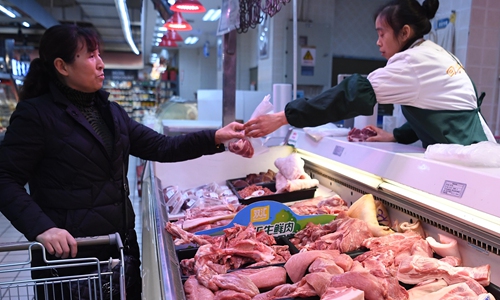HOME >> SOURCE
CPI for 2019 within target
By Yang Kunyi Source:Global Times Published: 2020/1/9 21:13:41
Figure suggests scope for loosening policy, analysts say

A resident buys pork in a supermarket in Southwest China's Chongqing Municipality on Monday. Photo: cnsphotos
China's consumer price index (CPI) was below the 3 percent target for 2019 and remained stable in December as pork prices leveled out, the National Bureau of Statistics (NBS) said on Thursday.Experts said stabilizing inflation and an expected rebound in factory activity are likely to create room for loosening policy.
China's CPI was up 2.9 percent for the whole year, under the 3 target set by the government, according to data released by the NBS on Thursday. The CPI was up 4.5 percent year-on-year in December, the same as in November and in line with market expectations.
Consumer prices stabilized as China's soaring pork prices began to level off. In December, pork prices skyrocketed by 97 percent year-on-year, contributing 2.34 percentage points to overall CPI growth. On a monthly basis, however, pork prices in December dropped 5.6 percent, compared with a 3.8 percent jump in November.
Dong Dengxin, director of the Finance and Securities Institute at Wuhan University of Science and Technology, told the Global Times that the CPI is expected to be stable but will remain elevated during the first quarter of 2020, due to the seasonal high demand for pork.
"As the Spring Festival approaches, the CPI is unlikely to drop, given the heavy weighting of pork in the calculation of the indicator," Dong said.
"However, the CPI for the whole year was still kept below 3 percent," Dong noted. "As pork supplies resume after the Spring Festival, inflation will be less of a consideration for the central bank's monetary policy."
China's producer price index (PPI), which measures the cost of goods at the factory gate, also showed a slight sign of recovery as it narrowed from a 1.4 percent drop in November to a decline of 0.5 percent in December, according to the NBS. A drop in the PPI suggests deflation, mirroring weak market demand.
The PPI's slower pace of decline indicates that the industrial sector was able to stabilize at the end of the year, and the reading was in line with other indicators for factory activity, according to a report by Yating Xu, senior economist at IHS Markit.
Both China's official manufacturing purchasing managers' index (PMI) and the Caixin PMI were above the expansion threshold in November and December, suggesting an improvement in domestic supply and demand with strong output and new orders sub-indexes.
"Considering rising oil prices, a rebound in infrastructure investment and a low base effect, the PPI is expected to turn positive in the first quarter," Xu said in the report.
The ease in deflationary pressure in the industrial sector was supported by increasing prices for manufacturing materials, including petroleum, coal and other fuels. The ferrous metal mining industry increased 8.8 percent year-on-year, and the petroleum and natural gas mining industries increased 5.8 percent, according to the NBS.
RELATED ARTICLES: